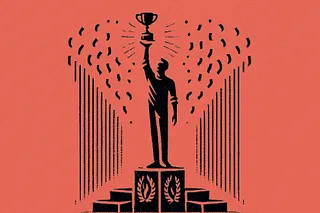How to prepare your kids for a future that looks radically different from your past.
Sixty-five percent.
That’s the percentage of kids entering elementary school today who will work in jobs that don’t exist yet. It’s hard for us to wrap our heads around, isn’t it? Like trying to train for a sport without knowing the rules, the shape of the field, or whether or not it’s even played with a ball. This is the future our kids are hurtling towards. Which means, they need to be building “future-proof” skills.
The familiar formula for success — study hard, get a degree, work the same job for 40 years, retire somewhere warm — is collapsing beneath the weight of technology and automation. Employees will no longer be rewarded for how long they’ve worked at the same firm or how high they’ve climbed the corporate ladder. Instead, their value will stem from their adaptability, their ingenuity, their resilience. The likelihood of your kid working the same job for forty years is low. Extremely low. Success isn’t just about working hard anymore. It’s about working smart.
So, what does that look like in the classroom? How do we prepare kids for volatile job markets and unstable careers? How do we ready kids for jobs that don’t even exist yet?
Four skills to future-proof your kid
Dozens of leading researchers agree: the future belongs to those who are adaptive, inventive, self-driven, and emotionally intelligent. These are the skills that will define whether kids sink or swim. But let’s strip away the corporate jargon and dive into what this actually looks like.
1. Agency (Translation: Thriving in chaos)

To be honest, I prefer the term “ownership.” The future will not be a straight line. It will be jagged, volatile, and indifferent to our expectations. Kids need to own their actions. The ability to pivot — with swift, nimble, and proactive feet — will be the defining skill of the post-AI era.
For example: it’s a random Tuesday morning in 2040. Your kid (now an adult) receives a message from their employer: their role is being phased out. It’s nothing personal. The algorithms are just better. How do they respond? Do they have the fortitude to pivot into an entirely new industry? The ability to keep their cool under pressure? The chutzpah to stay positive and ambitious in high-stress situations that don’t work in their favor?
“Learned helplessness” is a psychological condition where individuals believe they have no control over the situation, so they simply give up. It starts early. In the classroom, this manifests when students experience multiple failures and thus conclude they are incapable of succeeding. Rather than thinking, “I have experienced failure,” they believe, “I am a failure.” (Big difference.)
Some factors that contribute to learned helplessness in the classroom:
Repeated academic failure (with little to no success mixed in)
Over-scaffolding (i.e. excessive assistance from educators that prevents students from building a sense of self-confidence)
Negative feedback from teachers
Lack of motivation
Disengagement
Frustration
Now that artificial intelligence is “on tap” (in the words of Gary Tan), the future is less about intellect and skill, more about grit and resilience. There is no space for victim mentalities; only action and agency. Agency is not delusional optimism, but an unshakeable sense of confidence and self-efficacy. It comes from millions of reps, of proving to yourself over and over again that you have what it takes tosimply figure it out. The world could be spinning, job markets failing, careers tanking, but those with agency will pull up their bootstraps, crack a smile, and say, “Is that all you got?”
2. Creative Problem-Solving (Translation: Thinking beyond the obvious)
Tough news: we’ve gotten creativity all wrong.
Many people think of creativity as a mystical trait, like an angel’s kiss bestowed at birth, and some of us just happened to be luckier than others. But that’s not the case. Creativity is a discipline. It can be taught and trained. And it remains our greatest evolutionary advantage. Creativity is defined as “the tendency to generate or recognize ideas, alternatives, or possibilities that may be useful in solving problems, communicating with others, and entertaining ourselves and others.”

AI is fast, but it is not original. It can predict the next word in a sentence but not the next great idea. This is where humans win — if they are trained for it. In the paper mentioned above, there are two significant ways to “train” creative problem-solving:
The mastery of knowledge
In order to think creatively about a problem, students must first have a deep understanding of the problem. Knowledge opens many doors — not just generic knowledge, but specific, detailed knowledge that has been consumed to the level of mastery.
The real-world application of knowledge
Once students have mastered knowledge, they need opportunities to apply it. Educators must create opportunities that reflect the real-world: complex, layered, with many different routes to the desired destination.
“For example, instead of asking students to find unusual uses for a paperclip, a task could challenge them to design a cost-effective and sustainable solution to a local waste management problem and giving them as much knowledge about the issue.”
The equation is simple: mastery of knowledge + the real-world application of knowledge = a creative problem-solver.
3. Self-Directed Learning (Translation: The relentless pursuit of excellence)
Academy Award-winner Matthew McConaughey once gave a famous speech about heroes.
“My hero is me in ten years,” he said. “I’m never going to be my hero, and that’s just fine with me. It gives me someone to keep on chasing.”
Safe to say, McConaughey is a self-directed learner. “Self-directed learning” happens when the student takes full ownership of their educational journey: setting goals, managing time, reflecting on their progress, pursuing excellence, and so on. They do not need the iron grip of authority to spur them into forward progress — their own intrinsic motivation is enough. (Matthew’s speech is only 60 seconds long; I highly recommend.)
In a nutshell, self-directed learning is the desire to grow and the belief that we will never stop growing. This is one of our core beliefs: kids are limitless. Limitless environments require space for kids to fail, but most importantly, space to fail safely. It requires teachers who:
Have a deep relationship with students so they are trusted in a time of need
Coach them that giving up on the ambitious goal isn’t the solution
Emotionally support them through the difficult time
Make them comfortable with failing as an essential part of learning
Motivate them to keep at it
As a character trait, the relentless pursuit of excellence will not flinch in the face of AI. It will enable students to stay curious, passionate, and yes, limitless.
4. Emotional Intelligence (Translation: Being human)
AI may automate entire jobs and swallow entire industries, but it will lack the ability to deeply understand humans. Motivations, emotions, and human tendencies will become even more important to understand. Which means that human-to-human skills will become more valuable, not less. Negotiation. Persuasion. Storytelling. Leadership. These are not soft skills. They are power skills.
A future-proof classroom is one that focuses heavily on collaboration, debate, and discussion. Yes, kids must learn to work with AI, but they also must learn how to lead, influence, persuade, connect, and inspire others despite AI.
How “future-proofing” works in the classroom
There are three fundamental ways to teach future-proof skills in the classroom: mastery-based learning, real-world application, and guided support. Our schools follow the two-hour learning model, which implements all of the above to future-proof kids in the classroom.
Agency
How do you teach agency? Simple. Mastery-based learning combats learned helplessness and instills agency. With mastery-based learning, kids:
Build confidence in their sense of self
Eliminate the “I’m just bad at this” mindset
Learn how to receive immediate and frequent feedback
Focus on effort over ability
Learn how to flex failure as a muscle, not a wound
Creative problem-solving
It says it in the definition: the two facets of creative problem-solving are mastery of knowledge and real-world application of knowledge. This is the ultimate one-two punch of education. And it will inevitably produce adults who can think beyond the obvious. With our two-hour learning model, kids get two hours of mastery learning in the morning and four hours of real-world application in the afternoon.Self-directed learning
Like McConaughey, we can teach students to chase the best version of themselves — and fall in love with the process. When kids master content, rather than merely complete tasks, they experience positive emotions. These emotions help them make the vital connection: effort pays off! Growth is fun! I love to learn! To arrive there, kids need:
Mastery-based progression
Proper support from Guides
Personalized learning
And opportunities to apply knowledge outside of the classroom.
Emotional intelligence
Perhaps the most nuanced skill to teach in the classroom, this is where the two-hour model excels. Kids become AI-fluent in the morning with their AI tutor; then spend their afternoons immersed in collaboration, discussion, and teamwork with Guides and other students.
Every parent wants their child to succeed. But the world is shifting beneath our feet. Success is no longer a test score, high GPA, or an Ivy League acceptance letter. Success for future generations means resilience. The ability not just to work hard, but to work smart. The capacity to think independently, pivot with confidence, lead with wisdom. And ultimately, the gusto to dig their heels in, crack a smile in the face of adversity, and say, “Is that all you got?”
About the Author
MacKenzie Price, a Stanford Psychology graduate, created the 2 Hour Learning model to revolutionize education by helping students master academics in just two hours a day. Her innovative approach began with Alpha School, where students thrive both academically and emotionally.


